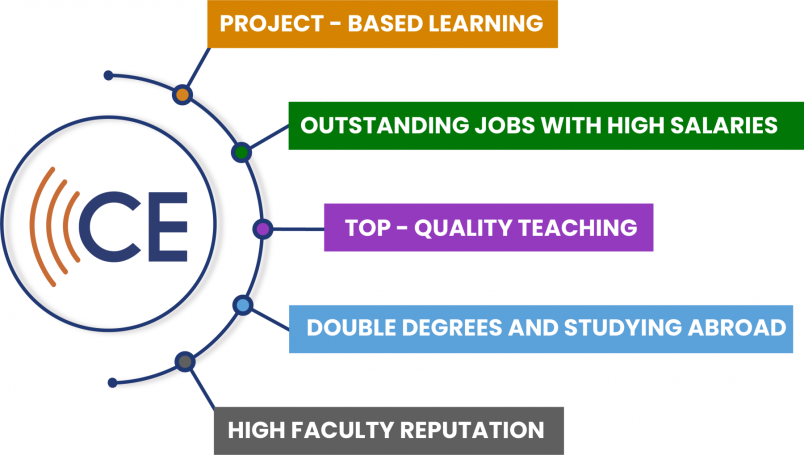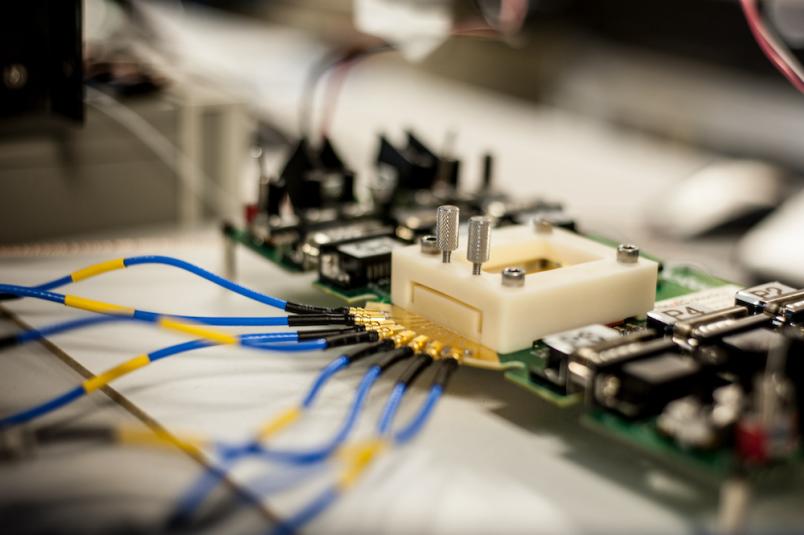
Il programma dei due anni fornisce una solida base in metodologie avanzate come machine learning, elaborazione dei segnali, teoria dell'informazione ed elettromagnetismo per la progettazione di sistemi di comunicazione, dai collegamenti ottici e wireless fino alle grandi reti. Nel secondo anno, potrai personalizzare il tuo piano di studi con corsi a scelta in linea con i tuoi interessi.
Acquisirai competenze in Python, Matlab, comunicazioni software-defined, gestione e controllo delle reti, simulazioni, misurazioni, trasmissioni ottiche e wireless, comunicazioni quantistiche, sicurezza, crittografia e deep learning.
Due semestri sono dedicati a progetti: uno sulle comunicazioni software-defined e un altro sui sistemi di comunicazione applicati e l'IoT. Il programma privilegia l'apprendimento pratico, con oltre 300 ore di formazione in laboratorio su comunicazioni wireless e ottiche, networking ed elaborazione dei segnali, più 300 ore dedicate alla tesi. Simulatori avanzati e digital twins potenziano l’esperienza pratica. I forti legami con l’industria offrono opportunità di stage, progetti di tesi, placement e seminari.
Trova qui le opportunità di studio all'estero e di doppia laurea.
Non perdere il programma con gli entusiasmanti argomenti trattati dal corso in Communications Engineering.

Grazie ai programmi di mobilità, è possibile studiare all’estero per un semestre; invece, nel caso dei seguenti programmi di doppia laurea, gli e le studenti devono spendere uno o più semestri nell’università straniera, secondo lo schema seguente:
| Università | Nazione | Semestri (Polito) | Semestri (estero) |
|---|---|---|---|
| EURECOM Sophia-Antipolis | France | 2 | 3 |
| INSA Lyon | France | 2 | 3 |
| Telecom ParisTech, Paris | France | 2 | 4 |
| Institut Polytechnique de Paris - IP Paris | France | 2 | 2 |
| Universitat Politècnica de Catalunya - UPC, Barcelona | Spain | 2 | 2 |
| KTH Royal Institute of Technology, Stockholm | Sweden | 2 | 3 |
| University of Illinois, Chicago | USA | 2 | 3 |

Year 1 - Semester 1
Communication and network systems [Computer network design and control]
- Network planning and management
- Routing and QoS-routing
- Cloud computing and virtualization
- Software defined networking
- Network slicing
- Traffic control algorithms and QoS support
- Congestion control
- Data distribution systems
Communication and network systems [Communication systems]
- Modern Communication Systems and their physical layer
- Wireless channel models (AWGN, multipath fading, Doppler)
- Multiplexing (TDM, FDM) and Multiple Access (TDMA, FDMA, CDMA, NOMA)
- Frame synchronization, Randomizers
- Introduction to error detection (CRC), error correction (block codes), and ARQ
- Digital modulations (PSK, QAM, APSK)
- OFDM modulation and its application
- Use cases and relative Link Budgets: space links and 5G
Signal, image and video processing and learning [Signal processing: methods and algorithms]
- Review of discrete-time signals and systems
- Introduction to non-stationary random processes
- Estimation theory
- Spectral estimation
- Time-frequency analysis
- The Kalman filter
- Detection theory
Signal, image and video processing and learning [Image and video processing and learning]
- Multidimensional filters and transforms
- Data, image and video compression
- Convolutional and deep neural networks for image analysis
- Generative adversarial networks
Machine learning for networking
- Programming in Python
- Machine Learning basics theory
- Preprocessing, data reduction and data visualization
- Supervised and unsupervised learning
- Applications and labs applied to Internet measurements and cybersecurity
Year 1 - Semester 2
Project: Software-defined communication systems
- Project management and planning
- Projects in these areas:
- Optical communications and networking
- Wireless systems and 5G networks
- Satellite networks
- Complex networks
- Networking for multimedia and music
- Project design, implementation and validation
- Periodic project presentations
Optical fiber communications
- Optical fiber networks: scenarios of application
- Introduction to the key optoelectronic components for optical fiber communications
- Linear and nonlinear propagation effects in single-mode optical fibers
- Intensity-modulated and direct detection (IM-DD) systems: performance and scalability in short reach scenario for datacenter and Fiber-to-the-Home optical access networks
- PM-QAM coherent transmission systems: performance and scalability for long haul ultra-high bit rate fiber links
- Long-haul reconfigurable optical networks (seminar given by external experts)
- Quantum cryptography (seminar given by external experts)
- Transoceanic submarine systems (seminar given by external experts)
Information and communication theory
- Basic concepts from Information Theory
- Source coding for data compression
- Channel capacity and capacity formula for the additive Gaussian channel
- An elementary introduction to block and convolutional codes
- Channel estimation (Single Carrier and OFDM)
- Adaptive Equalization ML and MMSE (Single Carrier and OFDM)
- Iterative channel decoders (LDPC, turbo, polar)
- Carrier, Timing and Frame Synchronization
Wireless access electromagnetics
- Introduction to antenna as system components
- Antenna system parameters
- Noiseless and noise link budget
- Low and medium gain antennas for broadcasting, mobile communications, WiFi/WLAN, IoT (slot, patch, dipole)
- UWB antennas
- High-gain, reconfigurable and MIMO antennas (arrays) with beamforming
- Fixed beam, scanning beam MIMO
Year 2 - Semester 1
Project: Applied communication systems and IoT
- Project management and planning
- Projects areas:
- Open control of optical transport network elements
- GNSS/GPS-related security
- Optical sensing
- Radar-based sensing
- High-speed optical links for datacenter/HPC applications
- IoT for smart applications
- Wireless-based sensing
- Communication system design, implementation and validation
- Periodic project presentations
Network measurement laboratory
- Configuration of hosts in Local Area Networks, IP addresses management, subnetting/supernetting
- Traffic monitoring using sniffers in LAN: TCP, UDP and HTTP
- Performance measurement for file transfers in wired and WiFi networks
- Impact of delay and packet losses
- Analysis of traffic traces collected from real networks
- Post-processing tools to extract information out of the raw data
- Statistical methods and data mining techniques to find correlations and solve classification problems
Signal processing and optical transmission lab
- Signal Processing laboratory:
- DSP implementation of linear filters and their application to lossless audio compression
- Program templates and input/output interfaces
- Basic FIR and IIR filtering structures
- Real-time filtering of audio signals
- Lossless coding based on FIR predictors
- Real-time lossless coding of audio signals, validation and testing
- Optical Communications laboratory
- Spectral measures of laser sources and their wavelength and power characterizations
- Experimental procedure for the joint of optical fibers and corresponding measurement of the joint attenuation
- Experimental characterization of passive optical devices
- Realization of an optical amplifier and corresponding experimental characterization
- Spectral characterization of optical sources through optical spectrum analyzers and high resolution methods
Signal processing and wireless transmission lab
- Signal digital processing laboratory
- Introduction to digital signals, DSP architecture and programming
- Introduction to CCS environment for running code on the DSP
- Entry-level C/C++ coding
- Implementation of digital FIR and IIR filters
- Porting from floating point to fixed point precision
- Live signal processing via double buffering
- Lossless coding, predictive error coding and Rice encoding
- Validation and testing
- Wireless transmissions laboratory
- Physical layer of broadband fixed and mobile radio-communication standards
- Structure and main functions of conventional and software defined digital radio transceivers
- Software defined radio (SDR) platforms Lab
- Implementation on SDR platform (Ettus B210 and National Instruments USRP-2901) of some common transceiver blocks suitable for most wireless communication standards (WiFi, LTE, DVB)
- Test and measurements of the performance of some implemented receiver algorithms
Open optical networks
- State-of-the art transceivers for optical communications
- Foundations of optical fiber propagation and modeling its impairments
- Amplifiers and passive components
- WDM spectral use and standards
- ROADMs and node structure in general
- YANG, Netconfig, GMPLS, OTN
- Emulation of optical layer in photonic networks
- Routing spectral and wavelength assignment
- Multilayer orchestration
- Physical-layer-aware network analysis, design and optimization
5G and next-generation mobile computing
- 5G and beyond cellular connectivity
- Network architecture
- Radio Access Networks
- Edge computing
- Mobile service virtualisation
- Virtual resource allocation
- Hands-on approach to mobile services
- Service orchestration
Advanced wireless communications and coding
- Multiuser uplink channels: orthogonal techniques and multiuser detection
- Multiple-antenna systems: receiver combining techniques, MIMO channel capacity, antenna arrays, beamforming
- Multiuser broadcast channels: degraded channel, NOMA, dirty-paper coding, linear precoding optimization
- Advanced coding and detection techniques for the wireless receiver
Satellite navigation systems
- Localisation and positioning techniques, radionavigation principles
- Uncertainty causes and error sources
- Basics of reference systems and satellite orbits
- Signal processing for radio-navigation
- System architecture of GPS and Galileo systems
- GNSS receivers architectures
- GNSS applications
Year 2 - Semester 2
Applied information security and cryptography
- Security concepts: confidentiality, integrity, non-repudiation
- Security models: types of attack, perfect security, computational security
- Symmetric-key cryptography: stream ciphers, block ciphers, authenticated encryption
- Public-key cryptography: key exchange/encapsulation, digital signatures, post-quantum cryptography
- Key distribution: certificates, public-key infrastructure, quantum key distribution
- Security applications: authentication, wireless security, transport layer security
Operational research
- How to build a mathematical optimization model
- Computational complexity
- Elements of network flows
- Local search heuristics
- Meta-heuristics (tabu search, simulated annealing, genetic algorithms, etc)
- Applications to optical networks (logical topology design, routing and wavelength assignment)
- Applications to green networking
Cloud computing and data center design lab
- Cloud computing e virtualization
- Data center topologies: leaf-spine, multilayer, Google Jupiter, hybrid optical/electronic switching
- Routing and traffic engineering in data centers: BGP protocol
- Architectures for advanced computing: hardware accelerators for Artificial Intelligence (AI)